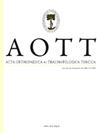Clinical outcomes of open-wedge corrective osteotomy using autogenous or allogenic bone grafts for malunited distal radius: A novel parameter for measuring the rate of bone union
IF 1.1
4区 医学
Q3 ORTHOPEDICS
引用次数: 2
Abstract
Objective: The aims of the study were (1) to compare outcomes in terms of malunited distal radius bone union in open-wedge corrective osteotomy using autogenous or allogenic bone and (2) to introduce a new parameter that quantifies the rate of the bone union. Methods: This retrospective study included 22 patients (14 males, 8 females) who underwent open-wedge corrective osteotomy with bone grafting for a malunited distal radius fracture between January 2006 and December 2018 were enrolled. The mean follow-up duration was 57.2 weeks (SD 46.1, range 12-206). All the patients were then divided into 1 of the 2 groups based on the graft material used: autogenous bone graft group (n = 10, 5 males and 5 females) and allogenic bone graft group (n = 12, 9 males and 3 females). We introduced the “duration of union/correction gap ratio” to represent the healing potential of each graft materials. Radiologic parameters including initial correction gap, radial inclination, radial length, palmar tilt, and ulnar variance were also measured pre- and postoperatively. Functional outcomes were assessed by grip strength, range of motion, and the disability of the Arm, Shoulder, and Hand score. Results: Of the 22 patients, 16 (72.7%) achieved complete union within 12 weeks, 3 (13.6%) in over 12 weeks, and the other 3 (13.6%) showed nonunion. Excluding the 3 nonunion cases, the mean union duration was 10.6 weeks, and the mean correction gap was 10 mm. The mean correction gap was wider in the autogenous bone graft group, and the mean union duration was longer in the allogenic bone graft group. Autogenous bone grafts had a significantly lower duration of bone union/correction gap ratio than allogenic bone grafts (0.76 vs. 1.61, P < 0.001). According to the correction method (simple open-wedge corrective osteotomy vs. open-wedge corrective osteotomy OWCO), only duration of bone union/correction gap ratio reflected the actual difference between values. Conclusion: Despite autogenous bone graft donor site morbidities, in our study, autogenous bone showed better bone healing potential than allogenic bone. In terms of bone union, autogenous bone has the benefit of better union in larger gaps than allogenic bone. Surgeons can take advantage of the newly introduced “duration of bone union/correction gap ratio” to compare the bone healing potential by graft materials or surgical options. Level of Evidence: Level IV, Therapeutic Study应用自体或同种异体骨移植物进行楔形开放矫正截骨治疗桡骨远端畸形愈合的临床结果:一种测量骨愈合率的新参数
目的:本研究的目的是:(1)比较使用自体骨或同种异体骨进行楔形开放矫正截骨时桡骨远端骨愈合不良的结果;(2)引入一个新的参数来量化骨愈合率。方法:这项回顾性研究包括22名患者(14名男性,8名女性),他们在2006年1月至2018年12月期间因桡骨远端骨折合并畸形接受了开放楔形矫正截骨和骨移植。平均随访时间为57.2周(SD 46.1,范围12-206)。然后根据所用的移植物材料将所有患者分为2组中的1组:自体骨移植物组(n = 10、5男5女)和同种异体骨移植组(n = 12、9名男性和3名女性)。我们引入了“愈合持续时间/矫正间隙比”来表示每种移植物材料的愈合潜力。术前和术后还测量了放射学参数,包括初始矫正间隙、桡骨倾斜度、桡骨长度、手掌倾斜度和尺骨变异。通过握力、活动范围和手臂、肩膀和手部残疾评分来评估功能结果。结果:22例患者中,16例(72.7%)在12周内完全愈合,3例(13.6%)在超过12周内愈合,另外3例(136%)出现骨不连。不包括3例骨不连病例,平均愈合时间为10.6周,平均矫正间隙为10mm。自体骨移植组的平均矫正间隙较宽,同种异体骨移植组平均愈合时间较长。自体骨移植物的骨愈合持续时间/矫正间隙比显著低于同种骨移植物(0.76 vs.1.61,P<0.001)。根据矫正方法(简单开放楔形矫正截骨与开放楔形矫正截骨术OWCO),只有骨融合持续时间/纠正间隙比反映了实际值之间的差异。结论:尽管自体骨移植物供区存在并发症,但在我们的研究中,自体骨显示出比同种异体骨更好的骨愈合潜力。在骨结合方面,自体骨比异体骨在更大的间隙中有更好的结合。外科医生可以利用新引入的“骨愈合持续时间/矫正间隙比”来比较移植材料或手术选择的骨愈合潜力。证据级别:IV级,治疗研究
本文章由计算机程序翻译,如有差异,请以英文原文为准。
求助全文
约1分钟内获得全文
求助全文
来源期刊

Acta orthopaedica et traumatologica turcica
ORTHOPEDICS-
CiteScore
2.00
自引率
0.00%
发文量
66
审稿时长
>12 weeks
期刊介绍:
Acta Orthopaedica et Traumatologica Turcica (AOTT) is an international, scientific, open access periodical published in accordance with independent, unbiased, and double-blinded peer-review principles. The journal is the official publication of the Turkish Association of Orthopaedics and Traumatology, and Turkish Society of Orthopaedics and Traumatology. It is published bimonthly in January, March, May, July, September, and November. The publication language of the journal is English.
The aim of the journal is to publish original studies of the highest scientific and clinical value in orthopedics, traumatology, and related disciplines. The scope of the journal includes but not limited to diagnostic, treatment, and prevention methods related to orthopedics and traumatology. Acta Orthopaedica et Traumatologica Turcica publishes clinical and basic research articles, case reports, personal clinical and technical notes, systematic reviews and meta-analyses and letters to the Editor. Proceedings of scientific meetings are also considered for publication.
The target audience of the journal includes healthcare professionals, physicians, and researchers who are interested or working in orthopedics and traumatology field, and related disciplines.
 求助内容:
求助内容: 应助结果提醒方式:
应助结果提醒方式:


